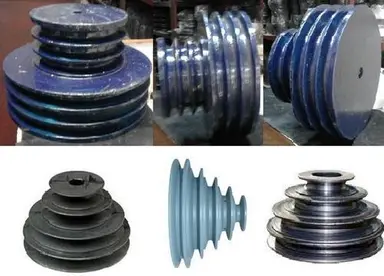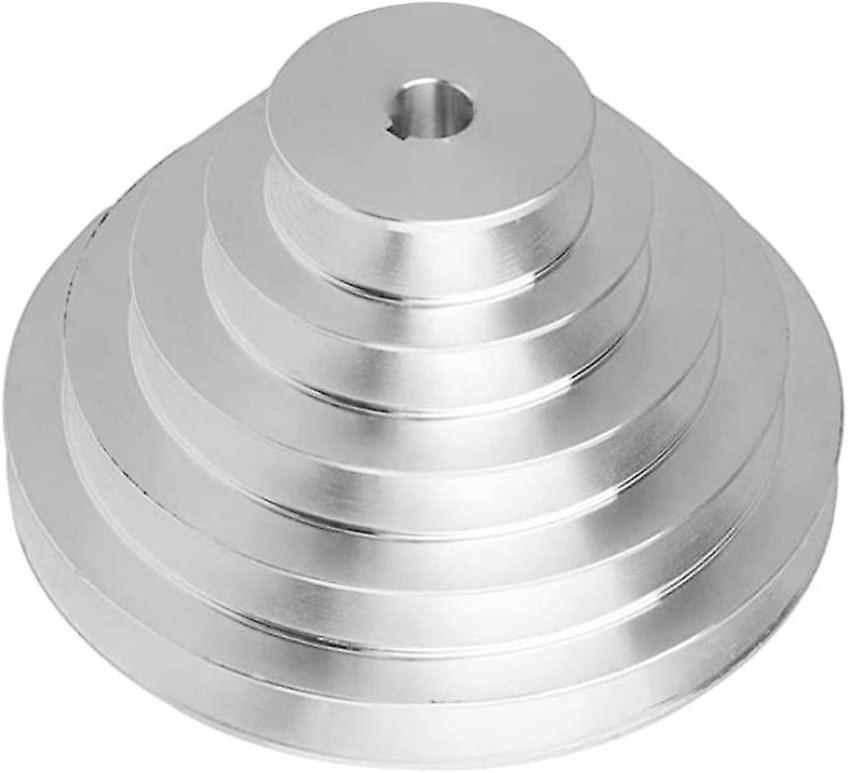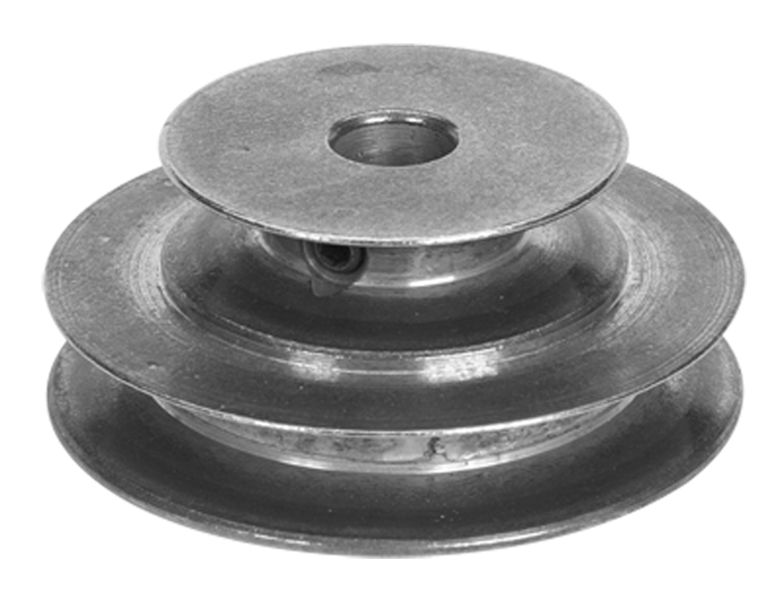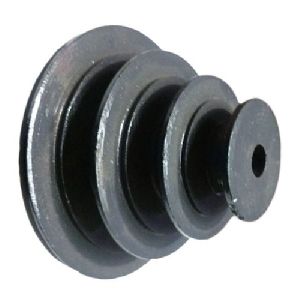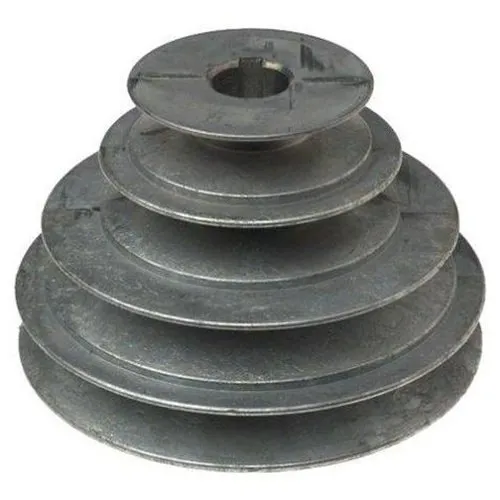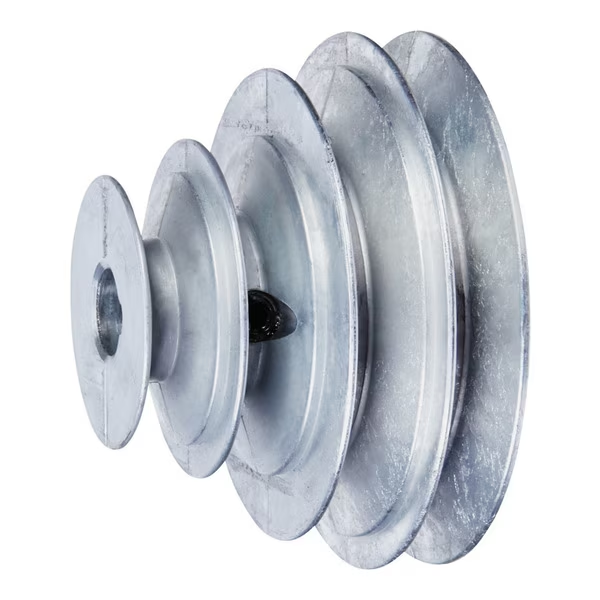Product Description
CHINAMFG Machinery offers a wide range of high quality Timing Belt Pulleys and Toothed Bars/ Timing Bars. Standard and non-standard pulleys according to drawings are available.
Types of material:
1. AlCuMgPb 6061 6082 Aluminum Timing Pulley
2. C45E 1045 S45C Carbon Steel Timing Pulley
3. GG25 HT250 Cast Iron Timing Pulley
4. SUS303 SUS304 AISI431 Stainless Steel Timing Pulley
5. Other material on demand, such as cooper, bronze and plastic
Types of surface treatment
1. Anodized surface -Aluminum Pulleys
2. Hard anodized surface — Aluminum Pulleys
3. Black Oxidized surface — Steel Pulleys
4. Zinc plated surface — Steel Pulleys
5. Chromate surface — Steel Pulleys; Cast Iron Pulleys
6. Nickel plated surface –Steel Pulleys; Cast Iron Pulleys
Types of teeth profile
| Teeth Profile | Pitch |
| HTD | 3M,5M,8M,14M,20M |
| AT | AT5,AT10,AT20 |
| T | T2.5,T5,T10 |
| MXL | 0.08″(2.032MM) |
| XL | 1/5″(5.08MM) |
| L | 3/8″(9.525MM) |
| H | 1/2″(12.7MM) |
| XH | 7/8″(22.225MM) |
| XXH | 1 1/4″(31.75MM) |
| STS STPD | S2M,S3M,S4.5M,S5M,S8M,S14M |
| RPP | RPP5M,RPP8M,RPP14M,RPP20M |
| PGGT | PGGT 2GT, 3GT and 5GT |
| PCGT | GT8M,GT14M |
Types of pitches and sizes
Imperial Inch Timing Belt Pulley,
1. Pilot Bore MXL571 for 6.35mm timing belt; teeth number from 16 to 72;
2. Pilot Bore XL037 for 9.53mm timing belt; teeth number from 10 to 72;
3. Pilot Bore, Taper Bore L050 for 12.7mm timing belt; teeth number from 10 to 120;
4. Pilot Bore, Taper Bore L075 for 19.05mm timing belt; teeth number from 10 to 120;
5. Pilot Bore, Taper Bore L100 for 25.4mm timing belt; teeth number from 10 to 120;
6. Pilot Bore, Taper Bore H075 for 19.05mm timing belt; teeth number from 14 to 50;
7. Pilot Bore, Taper Bore H100 for 25.4mm timing belt; teeth number from 14 to 156;
8. Pilot Bore, Taper Bore H150 for 38.1mm timing belt; teeth number from 14 to 156;
9. Pilot Bore, Taper Bore H200 for 50.8mm timing belt; teeth number from 14 to 156;
10. Pilot Bore, Taper Bore H300 for 76.2mm timing belt; teeth number from 14 to 156;
11. Taper Bore XH200 for 50.8mm timing belt; teeth number from 18 to 120;
12. Taper Bore XH300 for 76.2mm timing belt; teeth number from 18 to 120;
13. Taper Bore XH400 for 101.6mm timing belt; teeth number from 18 to 120;
Metric Timing Belt Pulley T and AT
1. Pilot Bore T2.5-16 for 6mm timing belt; teeth number from 12 to 60;
2. Pilot Bore T5-21 for 10mm timing belt; teeth number from 10 to 60;
3. Pilot Bore T5-27 for 16mm timing belt; teeth number from 10 to 60;
4. Pilot Bore T5-36 for 25mm timing belt; teeth number from 10 to 60;
5. Pilot Bore T10-31 for 16mm timing belt; teeth number from 12 to 60;
6. Pilot Bore T10-40 for 25mm timing belt; teeth number from 12 to 60;
7. Pilot Bore T10-47 for 32mm timing belt; teeth number from 18 to 60;
8. Pilot Bore T10-66 for 50mm timing belt; teeth number from 18 to 60;
9. Pilot Bore AT5-21 for 10mm timing belt; teeth number from 12 to 60;
10. Pilot Bore AT5-27 for 16mm timing belt; teeth number from 12 to 60;
11. Pilot Bore AT5-36 for 25mm timing belt; teeth number from 12 to 60;
12. Pilot Bore AT10-31 for 16mm timing belt; teeth number from 15 to 60;
13. Pilot Bore AT10-40 for 25mm timing belt; teeth number from 15 to 60;
14. Pilot Bore AT10-47 for 32mm timing belt; teeth number from 18 to 60;
15. Pilot Bore AT10-66 for 50mm timing belt; teeth number from 18 to 60;
Metric Timing Belt Pulley HTD3M, 5M, 8M, 14M
1. HTD3M-06; 3M-09; 3M-15; teeth number from 10 to 72;
2. HTD5M-09; 5M-15; 5M-25; teeth number from 12 to 72;
3. HTD8M-20; 8M-30; 8M-50; 8M-85 teeth number from 22 to 192;
4. HTD14M-40; 14M-55; 14M-85; 14M-115; 14M-170; teeth number from 28-216;
5. Taper Bore HTD5M-15; 8M-20; 8M-30; 8M-50; 8M-85; 14M-40; 14M-55; 14M-85;
14M-115; 14M-170
Metric Timing Belt Pulleys for Poly Chain GT2 Belts
1. PCGT8M-12; PCGT8M-21; PCGT8M-36; PCGT8M-62;
2. PCGT14M-20; PCGT14M-37; PCGT14M-68; PCGT14M-90; PCGT14M-125;
Power Grip CHINAMFG Tooth/ PGGT 2GT, 3GT and 5GT
1. 2GT-06, 2GT-09 for timing belt width 6mm and 9mm
2. 3GT-09, 3GT-15 for timing belt width 9mm and 15mm
3. 5GT-15, 5GT-25 for timing belt width 15mm and 25mm
CHINAMFG RPP HTD Timing Pulleys
1. RPP3M-06; 3M-09; 3M-15; teeth number from 10 to 72;
2. RPP5M-09; 5M-15; 5M-25; teeth number from 12 to 72;
3. RPP8M-20; 8M-30; 8M-50; 8M-85 teeth number from 22 to 192;
4. RPP14M-40; 14M-55; 14M-85; 14M-115; 14M-170; teeth number from 28-216;
5. Taper Bore RPP5M-15; 8M-20; 8M-30; 8M-50; 8M-85; 14M-40; 14M-55; 14M-85;
14M-115; 14M-170 /* January 22, 2571 19:08:37 */!function(){function s(e,r){var a,o={};try{e&&e.split(“,”).forEach(function(e,t){e&&(a=e.match(/(.*?):(.*)$/))&&1
| Pulley Sizes: | Timing |
|---|---|
| Manufacturing Process: | Sawing |
| Material: | Aluminum |
| Customization: |
Available
| Customized Request |
|---|
.shipping-cost-tm .tm-status-off{background: none;padding:0;color: #1470cc}
|
Shipping Cost:
Estimated freight per unit. |
about shipping cost and estimated delivery time. |
|---|
| Payment Method: |
|
|---|---|
|
Initial Payment Full Payment |
| Currency: | US$ |
|---|
| Return&refunds: | You can apply for a refund up to 30 days after receipt of the products. |
|---|
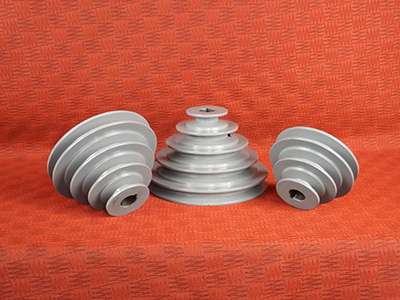
How do step pulleys contribute to the functionality of drill presses and lathes?
Step pulleys play a crucial role in enhancing the functionality of drill presses and lathes. Here’s how they contribute:
1. Variable Speed Control:
Step pulleys enable variable speed control in drill presses and lathes, allowing users to adjust the rotational speed of the spindle or workpiece. By changing the position of the drive belt on different steps of the pulley, operators can select different speed settings to match the requirements of various materials, cutting tools, or machining operations. This versatility in speed control enhances the precision and flexibility of these machines.
2. Wide Speed Range:
Step pulleys provide a wide range of speed options in drill presses and lathes. The pulley system typically consists of multiple steps with different diameters, each corresponding to a specific speed ratio. This allows users to choose the desired speed within the available range, accommodating a variety of cutting or drilling tasks, from high-speed operations to slow and precise operations.
3. Easy Speed Changes:
Changing the speed on a drill press or lathe equipped with step pulleys is relatively straightforward. By manually adjusting the position of the drive belt on the pulley steps or by engaging different pulley combinations (in machines with multiple pulleys), operators can quickly switch between speed settings. This ease of speed changes enables efficient workflow and facilitates adaptability to different machining requirements.
4. Cost-Effective Solution:
Step pulleys provide a cost-effective speed control mechanism for drill presses and lathes. Compared to more complex electronic speed control systems or variable frequency drives, step pulleys are relatively simple and affordable. They offer a reliable and efficient means of achieving variable speed functionality without the need for sophisticated electronic components or significant additional costs.
5. Reliable and Durable:
Step pulleys are known for their reliability and durability, making them suitable for the demanding operations of drill presses and lathes. They are designed to withstand high rotational speeds and heavy loads, ensuring consistent performance over extended periods of use. With proper maintenance and lubrication, step pulleys can provide long-lasting service in these machining applications.
6. Compatibility with Belts or Cables:
Step pulleys are compatible with various types of belts or cables, allowing for flexibility in the selection of power transmission components. Drill presses and lathes can be equipped with V-belts, flat belts, or even cables, depending on the specific requirements of the machine and the desired power transmission characteristics. This compatibility enhances the versatility and adaptability of the pulley system.
Overall, step pulleys significantly enhance the functionality of drill presses and lathes by providing variable speed control, a wide speed range, easy speed changes, cost-effective solutions, reliability, and compatibility with different power transmission components. These features empower operators to perform a broad range of machining tasks with precision and efficiency.
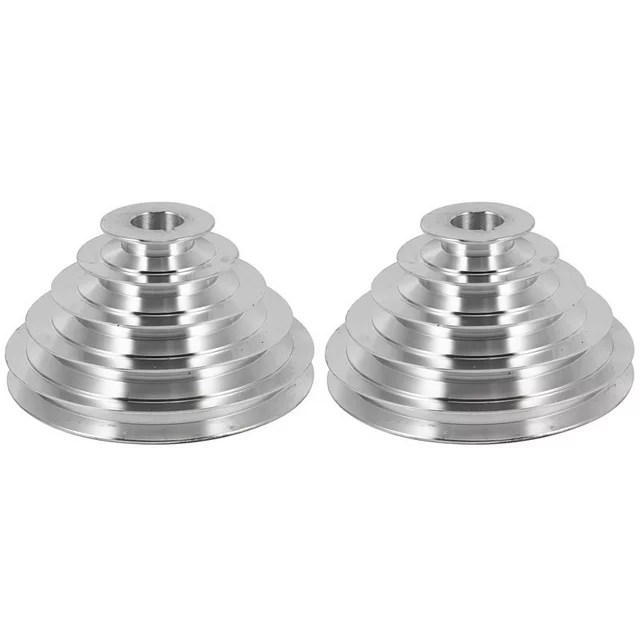
How do step pulleys contribute to energy efficiency in industrial processes?
Step pulleys play a significant role in improving energy efficiency in various industrial processes. Here are some ways in which step pulleys contribute to energy efficiency:
1. Speed Control:
Step pulleys allow for precise speed control in machinery and equipment. By adjusting the belt position on different steps of the pulley, operators can optimize the rotational speed of the driven components. This enables matching the speed to the specific requirements of the process, preventing unnecessary energy consumption.
2. Variable Speed Options:
With multiple steps on the pulley, each corresponding to a different speed ratio, step pulleys offer a range of variable speed options. This versatility allows operators to select the most efficient speed for different tasks or materials. By operating at the optimal speed, energy waste is minimized, resulting in improved energy efficiency.
3. Power Transmission Efficiency:
Step pulleys contribute to power transmission efficiency in machinery and equipment. By selecting the appropriate step and corresponding belt position, the pulley ensures that power is transmitted efficiently from the driving source to the driven components. This optimization minimizes energy loss and maximizes the use of available power.
4. Load Matching:
Step pulleys enable load matching, which involves adjusting the speed of the machine to match the load requirements. In industrial processes where the load fluctuates, step pulleys allow operators to optimize the speed to match the changing demands. This prevents overloading the system and reduces energy waste.
5. Reduced Overheating:
Efficient speed control provided by step pulleys helps reduce overheating in machinery. By operating at the appropriate speed, the machine can avoid excessive friction and heat generation. This results in lower energy consumption and extends the lifespan of the equipment.
6. Energy Conservation:
By optimizing the speed and power transmission, step pulleys contribute to overall energy conservation in industrial processes. The ability to adjust the speed according to specific requirements ensures that energy is utilized only when necessary, reducing wastage and lowering energy consumption.
7. Customization for Specific Applications:
Step pulleys allow customization of machinery for specific applications, optimizing energy usage. Different materials or processes may require different operating speeds. Step pulleys enable operators to tailor the machine’s performance to meet the specific energy requirements of each application, resulting in improved efficiency.
8. Potential for Energy Recovery:
In some cases, step pulleys can be integrated into systems that allow for energy recovery. For example, in systems with regenerative braking, step pulleys can assist in capturing and redirecting energy that would otherwise be wasted, further enhancing energy efficiency.
By providing precise speed control, variable speed options, power transmission efficiency, load matching capabilities, reduced overheating, energy conservation, customization for specific applications, and the potential for energy recovery, step pulleys significantly contribute to energy efficiency in industrial processes. Their role in optimizing energy usage and reducing waste makes them valuable components in various industries.
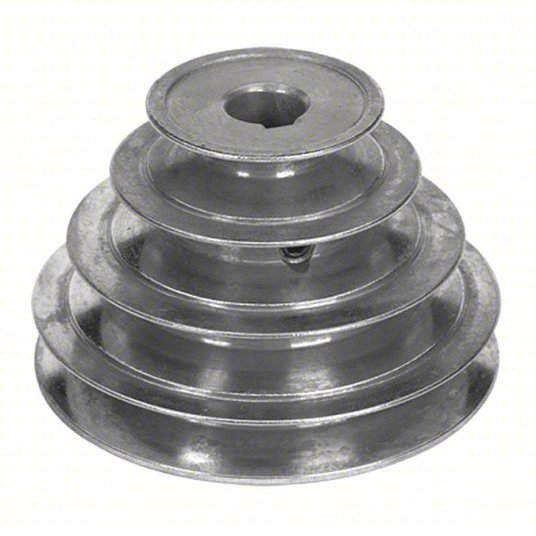
What types of belts or cables are typically employed with step pulleys?
Step pulleys are commonly used with specific types of belts or cables that are suitable for power transmission and engagement with the pulley’s steps. Here are some typical belt and cable options employed with step pulleys:
1. V-Belts:
V-belts are one of the most widely used types of belts with step pulleys. They have a trapezoidal cross-section and are designed to fit into the V-shaped grooves on the steps of the pulley. V-belts offer good power transmission capabilities and are known for their high frictional grip.
2. Flat Belts:
Flat belts, as the name suggests, have a flat cross-section. They are often made of materials like rubber, nylon, or leather. Flat belts are suitable for step pulleys that have wider and flatter steps. They provide reliable power transmission but may have lower grip compared to V-belts.
3. Synchronous Belts:
Synchronous belts, also known as timing belts, have teeth on the inner surface. They are designed to engage with matching teeth on the steps of the pulley. Synchronous belts offer precise power transmission and are commonly used in applications where accurate timing and synchronization are required.
4. Chain and Sprocket:
In some cases, step pulleys may be employed with chains and sprockets instead of belts. Chains with matching pitch and sprockets with corresponding teeth engage with the pulley steps, providing durable and efficient power transmission. Chain and sprocket setups are often used in heavy-duty applications.
5. Cable and Sheave:
For certain applications, such as in elevators or cranes, step pulleys may be used with cables and sheaves. The cable is wound around the sheave on the pulley, allowing for smooth and controlled movement.
The choice of belt or cable depends on factors such as the specific application, power requirements, speed range, and environmental conditions. It’s important to select the appropriate belt or cable that can effectively engage with the steps of the step pulley and provide reliable power transmission.


editor by CX
2024-05-15
